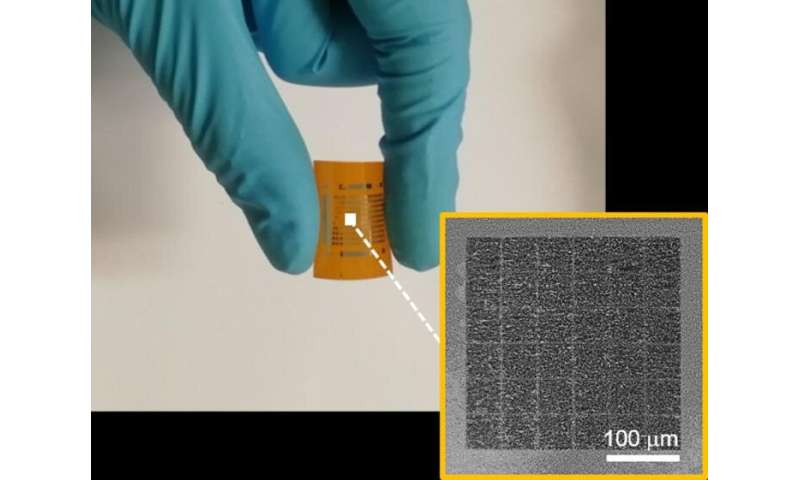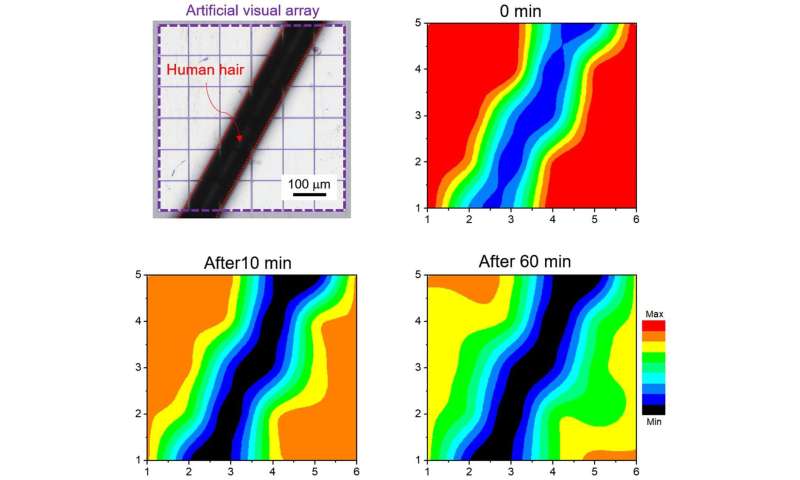
A joint study led by City University of Hong Kong (CityU) has built an ultralow-power consumption artificial visual system to mimic the human brain, which successfully performed data-intensive cognitive tasks. Their experiment results could provide a promising device system for the next generation of artificial intelligence (AI) applications.
The research team is led by Professor Johnny Chung-yin Ho, Associate Head and Professor of the Department of Materials Science and Engineering (MSE) at CityU. Their findings have been published in the scientific journal Science Advances, titled "Artificial visual system enabled by quasi-two-dimensional electron gases in oxide superlattice nanowires."
As the advances in semiconductor technologies used in digital computing are showing signs of stagnation, neuromorphic (brain-like) computing systems have been regarded as one alternative. Scientists have been trying to develop the next generation of advanced AI computers, which could be as lightweight, energy-efficient and adaptable as the human brain.
"Unfortunately, effectively emulating the brain's neuroplasticity—the ability to change its neural network connections or re-wire itself—in existing artificial synapses through an ultralow-power manner is still challenging," said Professor Ho.
Enhancing energy efficiency of artificial synapses
Artificial synapses emulate biological synapses, the gap across which the two neurons pass electrical signals to communicate with each other in the brain. Artificial synapses mimic the brain's efficient neural signal transmission and memory formation process.
To enhance the energy efficiency of artificial synapses, Professor Ho's research team has introduced quasi-two-dimensional electron gases (quasi-2DEGs) into artificial neuromorphic systems for the first time. The researchers developed oxide superlattice nanowires—a kind of semiconductor with intriguing electrical properties—and designed quasi-2DEG photonic synaptic devices that have achieved a record-low energy consumption down to sub-femtojoule (0.7fJ) per synaptic event. It means a decrease of 93% energy consumption when compared with synapses in the human brain.
"Our experiments have demonstrated that the artificial visual system based on our photonic synapses could simultaneously perform light detection, brain-like processing and memory functions in an ultralow-power manner. We believe our findings can provide a promising strategy to build artificial neuromorphic systems for applications in bionic devices, electronic eyes, and multifunctional robotics in future," said Professor Ho.

Resembling conductance change in synapses
He explained that a two-dimensional electron gas occurs when electrons are confined to a two-dimensional interface between two materials. Since there are no electron-electron interactions and electron-ion interactions, the electrons move freely in the interface.
Upon exposure to light pulse, a series of reactions between the oxygen molecules from the environment absorbed onto the nanowire surface and the free electrons from the two-dimensional electron gases inside the oxide superlattice nanowires were induced. Hence, the conductance of the photonic synapses would change. Given the outstanding charge carrier mobility and sensitivity to light stimuli of superlattice nanowires, the change of conductance in the photonic synapses resembles that in biological synapses. The quasi-2DEG photonic synapses thus mimic how the neurons in the human brain transmit and memorize signals.
A combo of photo-detection and memory functions
"The special properties of the superlattice nanowire materials enable our synapses to have both the photo-detecting and memory functions simultaneously. The nanowire superlattice cores can detect the light stimulus with high sensitivity, and the nanowire shells promote the memory functions. So there is no need to construct additional memory modules for charge storage in an image sensing chip. As a result, our device can save energy," explained Professor Ho.
With this quasi-2DEG photonic synapse, they have built an artificial visual system that can accurately and efficiently detect a patterned light stimulus and "memorize" the shape of the stimulus for an hour. "It is just like our brain remembers what we saw for some time," said Professor Ho.
He added that the way the team synthesised the photonic synapses and the artificial visual system did not require complex equipment. And the devices could be made on flexible plastics in a scalable and low-cost manner.
Provided by City University of Hong Kong
Citation: Artificial visual system of record-low energy consumption for the next generation of AI (2020, December 11) retrieved 11 December 2020 from https://ift.tt/3m6SW2v
This document is subject to copyright. Apart from any fair dealing for the purpose of private study or research, no part may be reproduced without the written permission. The content is provided for information purposes only.
"consumption" - Google News
December 11, 2020 at 07:31PM
https://ift.tt/3m6SW2v
Artificial visual system of record-low energy consumption for the next generation of AI - Tech Xplore
"consumption" - Google News
https://ift.tt/2WkKCBC
https://ift.tt/2YCP29R
Bagikan Berita Ini














0 Response to "Artificial visual system of record-low energy consumption for the next generation of AI - Tech Xplore"
Post a Comment